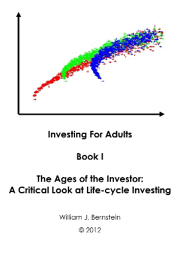
A recurring theme in investing is that you start out learning the simple basics, then you feel like you can optimize things and spend a lot of effort trying to do so, and eventually you realize that simple is probably just fine. No matter how closely you mine the past, you can’t predict the future. As the Buffett quote goes, “If past history was all there was to the game, the richest people would be librarians.” That’s what came to mind when I read William Bernstein on safe withdrawal rates in retirement:
Even the most sophisticated retirement projections contain so much uncertainty that the entire process can be summarized as follows: Below the age of 65, a 2% spending rate is bulletproof, 3% is probably safe, and 4% is taking chances. Above 5%, you’re taking an increasingly serious risk of dying poor. (For each five years above 65, add perhaps half of a percentage point to those numbers.)
Source: The Ages of the Investor: A Critical Look at Life-cycle Investing.
Something to keep in mind when you become obsessed about getting from a 98% success rate to a 99% success rate on a simple retirement calculator from Vanguard or a fancy one like FIRECalc. (Not that I’ve done that, ever, of course…)
 The Best Credit Card Bonus Offers – 2025
The Best Credit Card Bonus Offers – 2025 Big List of Free Stocks from Brokerage Apps
Big List of Free Stocks from Brokerage Apps Best Interest Rates on Cash - 2025
Best Interest Rates on Cash - 2025 Free Credit Scores x 3 + Free Credit Monitoring
Free Credit Scores x 3 + Free Credit Monitoring Best No Fee 0% APR Balance Transfer Offers
Best No Fee 0% APR Balance Transfer Offers Little-Known Cellular Data Plans That Can Save Big Money
Little-Known Cellular Data Plans That Can Save Big Money How To Haggle Your Cable or Direct TV Bill
How To Haggle Your Cable or Direct TV Bill Big List of Free Consumer Data Reports (Credit, Rent, Work)
Big List of Free Consumer Data Reports (Credit, Rent, Work)
Can we still withdraw Roth IRA contributions at any time? Wondering if times have changed…
That’s kind of sobering. As is the idea that 98% success rate is good enough. I’m not getting on any airplane that has a 2% chance of failing to land successfully.
I think the idea is that 98% or 99% is illusory anyway, including the idea that if you reach 100% you’ll be fine.
Spending less out of a portfolio is always going to help make it last longer, but building in some real-world flexibility is going to be more powerful than tweaking asset classes in a backtested portfolio simulation.